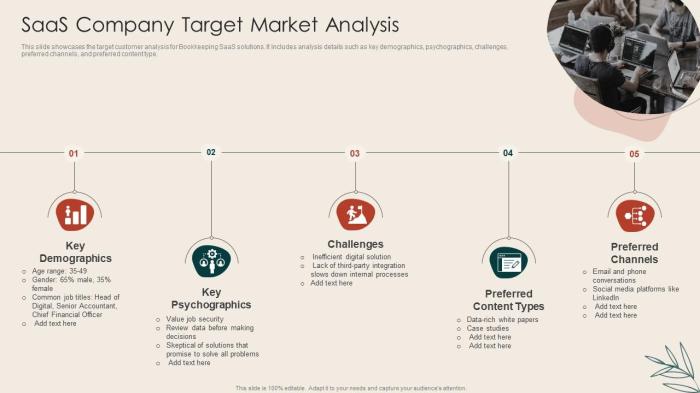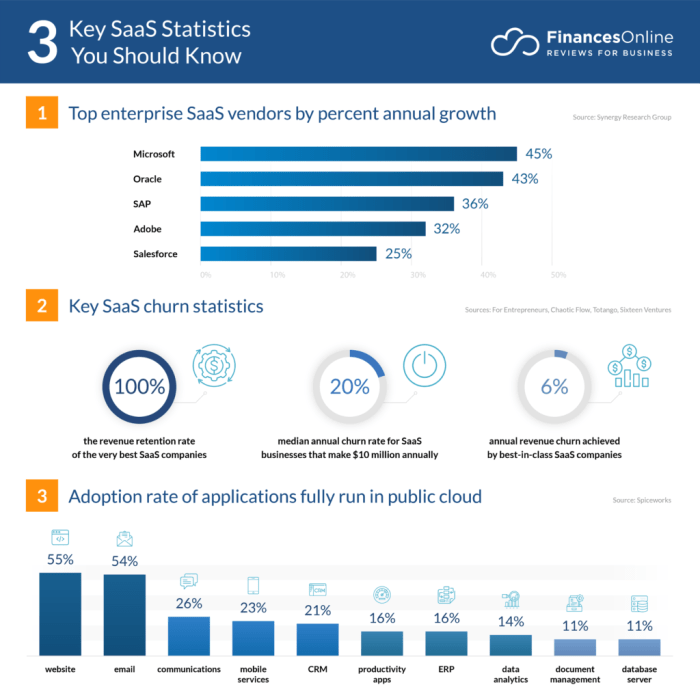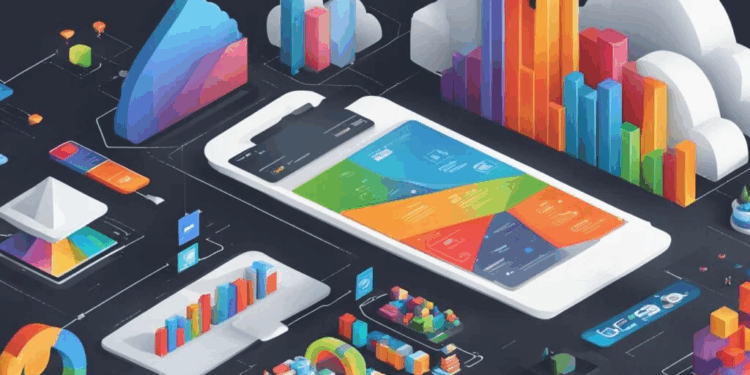
Embarking on a journey through the realm of SaaS market analysis, this introductory passage aims to intrigue and inform readers, offering a glimpse into the dynamic landscape of software as a service.
Delving deeper into the intricacies of market segmentation, competitive landscapes, and market dynamics, this discussion aims to unravel the complexities of the SaaS industry.
Overview of the SaaS Market
The Software as a Service (SaaS) market refers to the delivery of software applications over the internet on a subscription basis. This model allows users to access applications from any device with an internet connection, eliminating the need for on-premises installation.
The SaaS market is significant as it offers cost-effective solutions, seamless updates, scalability, and accessibility from anywhere, making it popular among businesses of all sizes.
Key Players in the SaaS Industry
In the SaaS industry, key players include giants like Salesforce, Microsoft, Adobe, and Oracle. These companies offer a wide range of cloud-based solutions for customer relationship management, productivity tools, marketing automation, and enterprise resource planning. Additionally, there is a growing number of emerging SaaS startups specializing in niche markets, providing innovative solutions to meet specific business needs.
Growth Trends and Projections for the SaaS Market
The SaaS market has been experiencing rapid growth in recent years, driven by the increasing adoption of cloud technology and the shift towards digital transformation. According to market research, the global SaaS market is projected to reach a value of $307.3 billion by 2026, with a compound annual growth rate (CAGR) of 11.7%.
This growth is fueled by the demand for flexible, cost-effective software solutions that can adapt to changing business requirements quickly.
Comparison with Traditional Software Markets
When comparing the SaaS market with traditional software markets, one notable difference is the pricing model. Traditional software is typically sold as a one-time license fee, while SaaS follows a subscription-based model. This subscription model offers lower upfront costs, easier scalability, and continuous updates and support, making it more appealing to businesses looking for flexible and agile solutions.
Additionally, SaaS applications are accessible from any device with an internet connection, providing users with greater mobility and convenience.
Market Segmentation

When it comes to the SaaS market, segmentation plays a crucial role in understanding the diverse landscape of software solutions available. Different segments cater to specific business needs and industries, contributing to the overall growth of the market.
CRM (Customer Relationship Management)
CRM software focuses on managing customer interactions and relationships, helping companies streamline sales, marketing, and customer service processes. This segment is essential for businesses looking to enhance customer satisfaction and retention.
- CRM software allows businesses to track customer interactions, manage leads, and analyze customer data to improve marketing strategies.
- Target Audience: Sales and marketing teams, customer service departments, and businesses looking to improve customer engagement.
- Growth Rate: The CRM segment has shown steady growth due to the increasing emphasis on customer-centric approaches in business.
ERP (Enterprise Resource Planning)
ERP software integrates core business processes such as finance, HR, inventory, and supply chain management into a single system, providing real-time data and insights for decision-making.
- ERP solutions help organizations streamline operations, improve efficiency, and optimize resource allocation.
- Target Audience: Large enterprises, manufacturing companies, and organizations seeking to enhance operational efficiency.
- Growth Rate: The ERP segment has experienced significant growth as businesses prioritize digital transformation and process automation.
Collaboration Tools
Collaboration tools enable teams to communicate, share files, and work together seamlessly regardless of location, fostering productivity and innovation within organizations.
- Collaboration software enhances teamwork, project management, and remote work capabilities, leading to improved collaboration and efficiency.
- Target Audience: Remote teams, project managers, and businesses aiming to enhance communication and collaboration among employees.
- Growth Rate: The collaboration tools segment has seen rapid growth with the rise of remote work and the need for virtual collaboration platforms.
Competitive Landscape
In the SaaS market, the competitive landscape is intense, with numerous players vying for market share and dominance. Major competitors in this space include Salesforce, Microsoft, Oracle, Adobe, and SAP, among others. These key players have established a strong presence in the market and continue to innovate to stay ahead of the competition.
Major Competitors and Market Share
- Salesforce: Leading the pack with a significant market share, Salesforce offers a wide range of cloud-based solutions for customer relationship management.
- Microsoft: With its Azure platform and Office 365 suite, Microsoft has also captured a large portion of the SaaS market.
- Oracle: Known for its enterprise software solutions, Oracle competes in various SaaS segments, including ERP and HR management.
- Adobe: Focused on creative software solutions, Adobe has carved out a niche in the SaaS market with its popular products like Adobe Creative Cloud.
- SAP: A powerhouse in the enterprise software space, SAP offers a suite of SaaS solutions for businesses of all sizes.
Strategies for Competitive Edge
- Continuous Innovation: Key players invest heavily in research and development to introduce new features and functionalities, attracting more customers.
- Partnerships and Integrations: Collaborating with other tech companies to enhance product offerings and reach a wider audience.
- Customization and Scalability: Providing flexible solutions that can be tailored to meet the unique needs of each business, ensuring customer satisfaction.
Market Consolidation and Mergers/Acquisitions
- Market consolidation is a common trend in the SaaS industry, with larger companies acquiring smaller ones to expand their product portfolio and customer base.
- Recent mergers and acquisitions include Salesforce's acquisition of Slack and Microsoft's acquisition of LinkedIn, indicating a move towards greater integration and synergy within the market.
- These consolidation efforts aim to strengthen the competitive position of the acquiring companies and drive further growth and innovation in the SaaS sector.
Market Dynamics
The SaaS market is driven by several key factors that have contributed to its rapid growth and expansion. Companies are increasingly adopting SaaS solutions due to their cost-effectiveness, scalability, and flexibility. As a result, the market continues to evolve to meet the changing needs of businesses and consumers alike.
Driving Factors Behind SaaS Market Growth
- Cost-Effectiveness: SaaS solutions eliminate the need for upfront investments in hardware and software, making them more affordable for businesses of all sizes.
- Scalability: SaaS platforms can easily scale up or down based on the growing needs of a business, providing flexibility and agility.
- Accessibility: Cloud-based SaaS applications can be accessed from anywhere with an internet connection, enabling remote work and collaboration.
Challenges Faced by SaaS Companies
- Security Concerns: Data privacy and security remain top concerns for SaaS companies, especially with the increase in cyber threats and data breaches.
- Competition: The SaaS market is highly competitive, with new entrants constantly challenging established players, leading to pricing pressures.
- Data Integration: Integrating SaaS applications with existing systems can be complex and time-consuming, posing a challenge for seamless operations.
Customer Preferences and Evolving Needs
- Personalization: Customers are increasingly demanding personalized experiences from SaaS providers, tailored to their specific needs and preferences.
- Mobile Capabilities: With the rise of mobile devices, customers expect SaaS applications to be mobile-friendly and accessible on-the-go.
- Data Analytics: Businesses are looking for SaaS solutions that offer advanced analytics and insights to drive informed decision-making and improve performance.
Impact of Technological Advancements
- AI and Machine Learning: SaaS companies are leveraging AI and machine learning technologies to enhance automation, predictive analytics, and customer experience.
- IoT Integration: The integration of IoT devices with SaaS platforms is enabling real-time data collection and analysis, leading to improved operational efficiency.
- Blockchain Technology: Blockchain is being explored by SaaS providers to enhance data security, transparency, and trust in transactions.
Outcome Summary

In conclusion, the diverse facets of SaaS market analysis paint a vivid picture of innovation, competition, and evolving consumer needs. As the industry continues to evolve, staying abreast of market trends and dynamics is paramount for success in this ever-changing landscape.
FAQ Resource
What are the key players in the SaaS industry?
Some of the major players in the SaaS industry include Salesforce, Microsoft, Adobe, and Oracle.
How do technological advancements impact the SaaS market?
Technological advancements such as AI and automation are transforming the SaaS market by enhancing user experience and increasing efficiency.
What are the growth trends and projections for the SaaS market?
The SaaS market is expected to continue growing rapidly, with projections showing increased adoption across various industry verticals.












